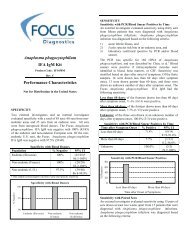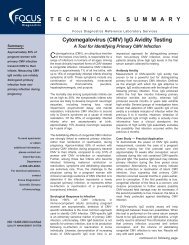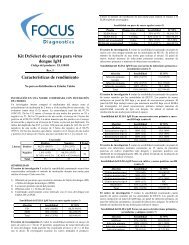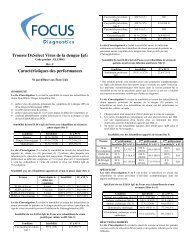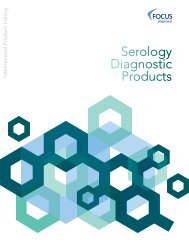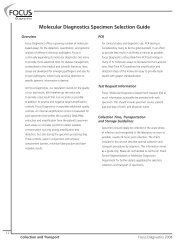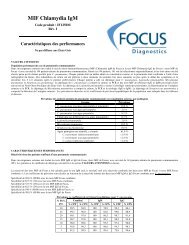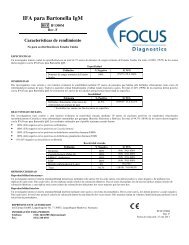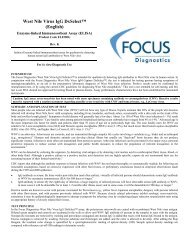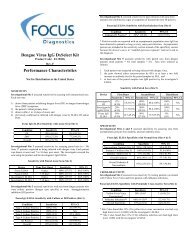West Nile Virus IgM Capture DxSelect⢠(English) - Focus Diagnostics
West Nile Virus IgM Capture DxSelect⢠(English) - Focus Diagnostics
West Nile Virus IgM Capture DxSelect⢠(English) - Focus Diagnostics
- No tags were found...
You also want an ePaper? Increase the reach of your titles
YUMPU automatically turns print PDFs into web optimized ePapers that Google loves.
FOCUS <strong>Diagnostics</strong><strong>West</strong> <strong>Nile</strong> <strong>Virus</strong> <strong>IgM</strong> <strong>Capture</strong> DxSelectPage 46. Use only protocols described in this insert. Incubation times or temperatures other than those specified may give erroneousresults.7. Cross-contamination of patient specimens can cause erroneous results. Add patient specimens and handle strips carefully to avoidmixing of sera from adjoining incubation tray wells. Decant carefully.8. Bacterial contamination of serum specimens or reagents can produce erroneous results. Use aseptic techniques to avoid microbialcontamination.9. The Stop Reagent contains sulfuric acid. Do not allow to contact skin or eyes. If exposed, flush with copious amounts of water.10. Sodium azide inhibits conjugate activity. Clean pipette tips must be used for the conjugate addition so that sodium azide is notcarried over from other reagents.SPECIMEN COLLECTION AND PREPARATIONThis test must be performed on serum only. The use of whole blood, plasma or other specimen matrix has not been established.Performance characteristics have not been established with hyper-lipemic, heat inactivated, hemolyzed, icteric, or contaminated sera.It is unknown if such specimens will cause erroneous results. Hyper-lipemic, heat inactivated, hemolyzed, icteric, and contaminatedsera must not be tested.Specimen Collection and HandlingCollect blood samples aseptically using approved venipuncture techniques by qualified personnel. Allow blood samples to clot atroom temperature prior to centrifugation. Aseptically transfer serum to a tightly closing sterile container for storage. Separated serumshould remain at 22C for no longer than 8 hours. If the assay will not be completed within 8 hours, refrigerate the sample at 2 to 8C.If the assay will not be completed within 48 hours, or for shipment of samples, freeze at –20C or colder. 8 Thaw and mix sampleswell prior to use.Serum Specimen, Controls and Calibrator PreparationDilute each serum specimen, serum control and calibrator 1:101. For example, label tubes and dispense 1000 L of Sample Diluentinto each labeled tube. Add 10 L of specimen, control or calibrator to each appropriate tube containing the 1000 L Sample Diluentand mix well by vortex mixing.TEST PROCEDUREPerform the assay at room temperature (approximate range 20 to 25C). Use proper pipetting techniques, maintaining the pipettingpattern throughout the procedure to ensure optimal and reproducible values. Performance characteristics have not been established forprocedures that are different from the procedure described below. Different procedures, e.g., different times, volumes, temperatures, orothers, may produce invalid results.1. Allow all reagents to warm to room temperature before use. Remove the <strong>IgM</strong> <strong>Capture</strong> Well packet from cold storage. To avoidcondensation, allow micro-well strips to reach room temperature before opening the foil packet. If less than a full plate is to beused, return unused strips to the foil packet with desiccant and reseal completely. Store unused <strong>IgM</strong> <strong>Capture</strong> Wells at 2 to 8C.(Note: At the end of the assay, retain the frame for use with the remaining strips.)2. Prepare Antigen Solution (make sure reagent has reached room temperature). If the kit is being used for the first time, reconstitutesufficient antigen (see Materials Supplied, above).3. Fill wells with 1X Wash Buffer solution (see Materials Supplied, above) and allow to soak for 5 minutes. Decant (or aspirate)the <strong>IgM</strong> <strong>Capture</strong> Wells and tap vigorously to remove Wash Buffer. Blot the emptied <strong>Capture</strong> Wells face down on clean papertowels or absorbant paper to remove residual Wash Buffer.4. Dispense 100 µL of the Sample Diluent into the "blank" well(s) and 100 µL of each diluted specimen, control or calibrator(see SPECIMEN COLLECTION AND PREPARATION, above) into the appropriate wells. (Note: For runs with more than 48wells it is recommended that 250 L of each diluted sample first be added to a blank microtiter plate in the location correspondingto that in the ELISA wells. The samples can then be efficiently transferred into the Antigen Wells with a 100 L 8 or 12-channelpipettor.)5. Cover plates with sealing tape, and incubate for 60 ± 1 minute at room temperature (20 to 25C).6. Remove sealing tape, and empty the contents of the wells into a sink or a discard basin.7. Fill each well (250 µL) with a gentle stream of 1X Wash Buffer solution then empty contents into a sink or a discard container.8. Repeat wash (step 7) an additional 2 times, allow the last wash to soak for five minutes before decanting or aspirating.9. Tap the <strong>Capture</strong> Wells vigorously to remove 1X Wash Buffer. Blot the emptied <strong>Capture</strong> Wells face down on clean paper towelsor absorbant paper to remove residual 1X Wash Buffer.10. Add the prepared (see Step 2, above) 100 L Antigen Solution to all wells, using a 100 L 8 or 12-channel pipettor.11. Cover plates with sealing tape and incubate for 2 hours at room temperature (20 to 25C).12. Repeat wash steps 6 through 9.13. Add 100 L of <strong>IgM</strong> Conjugate to all wells, using a 100 L 8 or 12-channel pipettor.14. Cover plates with sealing tape, and incubate for 30 ± 1 minute at room temperature (20 to 25C).15. Repeat wash steps 6 through 9.
FOCUS <strong>Diagnostics</strong><strong>West</strong> <strong>Nile</strong> <strong>Virus</strong> <strong>IgM</strong> <strong>Capture</strong> DxSelectPage 516. Add 100 L of Substrate Reagent to all wells, using a 100 L 8 or 12-channel pipettor. Begin incubation timing with theaddition of Substrate Reagent to the first well. (Note: Never pour the substrate reagent into the same trough as was used for theconjugate.)17. Incubate for 10 ± 1 minutes at room temperature (20 to 25C).18. Stop the reaction by adding 100 L of Stop Reagent to all wells using a 100 L 8 or 12-channel pipettor. Add the Stop Reagentin the same sequence and at the same pace as the Substrate was added. In antibody-positive wells, color should change from blueto yellow.19. Gently blot the outside bottom of wells with a paper towel to remove droplets that may interfere with reading by thespectrophotometer. Do not rub with the paper towel as it may scratch the optical surface of the well. (Note: Large bubbles on thesurface of the liquid may affect the OD readings.)20. Measure the absorbance of each well within 1 hour of stopping the assay. Set the microwell spectrophotometer at a wavelength of450 nm. Zero the instrument on the blank wells.<strong>IgM</strong> Procedure (condensed version)1. Dilute samplesSerum samples and Controls:1:101 in Sample Diluent. (e.g., 10 L + 1000 L)2. Soak Wells for 5 minutes with 1X Wash, decant.3. 100 L of sample for 60 minutes, decant.Background subtract only: 100 L of diluted sample is added to each of two wells. One well (the "Ag" well, "Ag" forantigen) gets WNV antigen in Step 5, and the other well (the "SD" well, "SD" for diluent) gets Sample Diluent in Step 5.Important note: Background subtract is one way to check for heterophile antibodies present in positive samples. Therefore,background subtract should not be performed unless the patient sample was initially positive.4. Wash 3 times.5. 100 L of Antigen for 120 minutes, decant.Background subtract only: Add 100 L of Antigen to the "Ag" well, and add 100 L Sample Diluent to the "SD" well,incubate for 120 minutes.6. Wash 3 times.7. 100 L of Conjugate for 30 minutes, decant.8. Wash 3 times.9. 100 L of Substrate Reagent for 10 minutes.10. 100 L of Stop Reagent, read at = 450 nm.Please see the PROCEDURE section for important details.QUALITY CONTROLEach plate run (or strips or wells from a single plate) must include the Cut-off Calibrator and the two Controls. If multiple plates arerun, include the Cut-off Calibrator and both controls on each plate. It is recommended that until the user becomes familiar with the kitperformance, all specimens, controls and the Cut-off Calibrator should be run in duplicate with the Cut-off Calibrator run twice for atotal of four wells. If single wells are used, the Cut-off Calibrator should be run in triplicate. Include a minimum of 1 blank well(containing sample diluent only) for instrument calibration purposes.The Cut-off Calibrator has been formulated to give the optimum differentiation between negative and positive sera. Although theabsorbance value may vary between runs and between laboratories, the mean value for the Cut-off Calibrator wells must be within0.100 to 0.700 OD units. All replicate Cut-off Calibrator ODs should be within 0.10 absorbance units from the mean value. Reportresults as index values relative to the Cut-off Calibrator. To calculate index values, divide specimen and control optical density (OD)values by the mean of the Cut-off Calibrator OD values.
FOCUS <strong>Diagnostics</strong><strong>West</strong> <strong>Nile</strong> <strong>Virus</strong> <strong>IgM</strong> <strong>Capture</strong> DxSelectPage 6Calculation for the Background Subtract ResultsStep 1. Calculate the Index for the Controls by dividing the Control OD by the Cut-off OD.Index for the Controls (Cut-off and Control Index) = "Ag" OD/CO ODStep 2. Calculate the Index for Patient Samples by first calculating the Net Patient OD (by subtracting the "SD" OD fromthe "Ag" OD), and then dividing the Net Patient OD by the Cut-off OD.Net Patient OD = "Ag" OD - "SD" ODIndex for Patient Samples = Net Patient OD/CO ODStep 3. Interpret using the ranges in the Interpretation section (e.g., negative < 0.90, and positive > 1.10).IDAg ODExample Calculation for Background Subtraction ResultsOD* Step 1 Step 2 Step 3SD ODDivide Control OD byCut-off ODAg OD /CO OD= Index for ControlsNeg Control 0.008 0.02Cut-off 0.400 1.00Pos Control 1.200 3.00Subtract SD OD fromAg ODAg OD – SD OD= Net OD for PatientsDivide the Net OD bythe Cut-off ODNet OD/CO OD= Index for PatientsInterpretationSpecimen A 0.860 0.020 0.840 2.10 POSSpecimen B 0.890 0.010 0.880 2.20 POSSpecimen C 0.760 0.720 0.040 0.10 NEG* Blank OD is already subtracted from each result.Discussion of Background Subtraction Example CalculationsSpecimen A and B should be interpreted as <strong>IgM</strong> positive because the index after subtracting the background is still greater than 1.10.(the wells with no antigen was not reactive).Specimen C demonstrates the importance of subtracting background. Sample C was reactive even when Sample Diluent was addedinstead of <strong>West</strong> <strong>Nile</strong> antigen, indicating that antibodies in the sample were cross-linking the <strong>IgM</strong> <strong>Capture</strong> antibodies and themonoclonal conjugate. Specimen C should be considered <strong>IgM</strong> negative because the index value after subtracting background was0.10, and 0.10 is less than 0.90 (thus in the negative interpretation zone).1. The Positive Control index values must be between 1.5 and 3.5.2. The Negative Control index values must be less than 0.8.If the Calibrator or Controls are not within these parameters, patient test results must be considered invalid and the assayrepeated. Invalid test results must not be reported.The Positive and Negative Controls are intended to monitor for substantial reagent failure. The Positive Control should not be used asan indicator for Cut-off Calibrator precision and only ensures reagent functionality. Quality control requirements must be performed inconformance with local, state, and/or federal regulations or accreditation requirements and your laboratory's standard Quality Controlprocedures. In the US, regulatory authorities recommend that the user refer to NCCLS C24-A and 42 CFR 493.1256 for guidance onappropriate QC practices.
FOCUS <strong>Diagnostics</strong><strong>West</strong> <strong>Nile</strong> <strong>Virus</strong> <strong>IgM</strong> <strong>Capture</strong> DxSelectPage 7INTERPRETATION OF TEST RESULTSTo calculate index values, divide specimen optical density (OD) values by the mean of the Cut-off Calibrator absorbance values.The magnitude of the index value above the Cut-off Calibrator does not indicate the total amount of antibody present.Cut-off Development. In designing the assay, the assay Cut-off was established to optimize both sensitivity and specificity by using315 sera submitted for <strong>West</strong> <strong>Nile</strong> testing consisting of four different serum panels (run without the background subtract method): 1) 98confirmed acute <strong>West</strong> <strong>Nile</strong> positive samples (PRNT positives); 2) 102 presumed acute <strong>West</strong> <strong>Nile</strong> positive samples (US Public Health<strong>IgM</strong> ELISA and/or in-house WNV native antigen <strong>IgM</strong> ELISA positive 9,10 ); 3) 108 presumed negative samples (US Public Health <strong>IgM</strong>ELISA and/or in-house WNV native antigen <strong>IgM</strong> ELISA negative); and 4) 7 ELISA discrepants (US Public Health <strong>IgM</strong> ELISAnegative and in-house WNV native antigen <strong>IgM</strong> ELISA positive). The <strong>Focus</strong> <strong>West</strong> <strong>Nile</strong> <strong>IgM</strong> was: positive with 99.0% (96/97) of theconfirmed acute <strong>West</strong> <strong>Nile</strong> positive samples (excluding one equivocal); positive with 99.0% (101/102) of the presumed acute <strong>West</strong><strong>Nile</strong> positive samples: negative with 100% (108/108) of the presumed negative samples; and negative with 71.4% (5/7) of the ELISAdiscrepant samples.<strong>IgM</strong>IndexInterpretation (<strong>IgM</strong> Result Only)> 1.10 <strong>IgM</strong> Positive. An index value of > 1.10 indicates <strong>IgM</strong> antibodies to <strong>West</strong> <strong>Nile</strong> virus were detected. The presence of <strong>IgM</strong> antibodies ispresumptive evidence that the patient was recently or is currently infected with <strong>West</strong> <strong>Nile</strong> virus or another flavivirus. Positive resultsmust be tested using the background subtraction method (either on the initial test or on a repeat test).A patient can be <strong>IgM</strong> positive but not currently infected with <strong>West</strong> <strong>Nile</strong> virus because of 1) cross-reactivity to other flaviviruses 2 or 2)<strong>IgM</strong> antibodies from previous infections may be present for over 500 days. 2 <strong>IgM</strong> Positive results reported for children must contain acaution statement regarding possible cross-reactivity with enteroviruses. <strong>IgM</strong> positive results must be confirmed by plaque reductionneutralization test, or by using the recent CDC guidelines for diagnosis of <strong>West</strong> <strong>Nile</strong> encephalitis. 1.10and 0.90<strong>IgM</strong> Equivocal. An index value of 0.90 but 1.10 is considered an equivocal result. It is recommended that samples with equivocalresults be tested using a different method, or the patient may be re-drawn two or more weeks later and re-tested with this assay.< 0.90 <strong>IgM</strong> Negative. An index value of < 0.90 indicates <strong>IgM</strong> antibodies to <strong>West</strong> <strong>Nile</strong> virus were not detected. The absence of <strong>IgM</strong> antibodiesis presumptive evidence that the patient was not recently infected with <strong>West</strong> <strong>Nile</strong> virus or another flavivirus.However, the sample may have been drawn before antibodies were detectable, or the patient may be immunosuppressed. If infection issuspected, then another sample should be drawn 7 to 14 days later and tested. Refer to CDC guidelines for diagnosis of <strong>West</strong> <strong>Nile</strong>encephalitis.If the <strong>Focus</strong> <strong>West</strong> <strong>Nile</strong> ELISA IgG results are also available for the same specimen then use the following interpretation:<strong>IgM</strong>ResultIgGResultCombined Interpretation (Both <strong>IgM</strong> & IgG Results)Pos Pos Presume the patient was recently infected with WNV. The presence of <strong>IgM</strong> antibodies is presumptive evidence that thepatient was recently or is currently infected with <strong>West</strong> <strong>Nile</strong> virus or another flavivirus. However, <strong>IgM</strong> anti-WNV has beenshown to persist for ≥ 500 days.Neg Refer to results above for <strong>IgM</strong> anti-WNV reactive results.Neg Pos Presume the patient was previously infected with (or exposed to) WNV. The presence of IgG antibodies without <strong>IgM</strong>antibodies is presumptive evidence that the patient was infected with (or exposed to) <strong>West</strong> <strong>Nile</strong> virus or another flavivirus atan undetermined time.Neg Presume the patient has not been infected (or exposed to) with WNV. The absence of <strong>IgM</strong> and IgG antibodies ispresumptive evidence that the patient has not been recently infected with (or exposed to) <strong>West</strong> <strong>Nile</strong> virus or anotherflavivirus.LIMITATIONS1. The performance of this assay has not been established for screening the general population. Testing should only be performed onpatients with clinical symptoms of meningioencephalitis.2. The performance of this assay has not been established for ruling out diseases with similar symptoms, e.g., herpes simplex virusencephalitis, enterovirus encephalitis, bacterial meningitis, causes of non-infectious encephalitis, or post-infectious encephalitis.3. The performance of this assay has not been established for matrices other than serum, or visual result determination(s), ormonitoring <strong>West</strong> <strong>Nile</strong> virus therapy.4. All results from this and other serologies must be correlated with clinical history, epidemiological data, and other data available tothe attending physician in evaluating the patient. Positive results must be confirmed by neutralization test, or by using the currentCDC guidelines for diagnosing <strong>West</strong> <strong>Nile</strong> encephalitis. 15. The prevalence of infection will affect the assay’s predictive value.6. This assay may cross-react with antibodies produced to other flaviviruses (e.g., dengue virus, Japanese encephalitis virus, St.Louis encephalitis virus, yellow fever virus, and others). These diseases must be excluded before confirmation of diagnosis.
FOCUS <strong>Diagnostics</strong><strong>West</strong> <strong>Nile</strong> <strong>Virus</strong> <strong>IgM</strong> <strong>Capture</strong> DxSelectPage 8EXPECTED VALUESThe prevalence of <strong>West</strong> <strong>Nile</strong> antibodies varies depending on age, geographic location, testing method used, and other factors. Acommunity based serosurvey for <strong>West</strong> <strong>Nile</strong> infection conducted in New York in 2000 found that 0.2% (5/2433) of persons testedoverall had antibodies indicating recent <strong>West</strong> <strong>Nile</strong> infection, and that 1.1% (2/176) of persons reporting a recent headache and feverhad antibodies indicating a recent <strong>West</strong> <strong>Nile</strong> infection. 11 Two serosurveys conducted in New York City (NYC) in 1999 and 2000showed that approximately 1 in 150 infections (
FOCUS <strong>Diagnostics</strong>Without Background SubtractThe <strong>Focus</strong> <strong>IgM</strong> assay was positive with 90.9% (40/44) of theconfirmed positive WNV encephalitis patients (including 2 <strong>Focus</strong>equivocals calculated as negatives). Of the 252 patients withpresumptive assay results, 250 were classified as presumed negativepatients (CDC WNV <strong>IgM</strong> ELISA negative), and 2 were classified aspresumed positive <strong>West</strong> <strong>Nile</strong> encephalitis patients (CDC WNV <strong>IgM</strong>ELISA positive). The <strong>Focus</strong> <strong>IgM</strong> assay was positive with 100% (2/2)of the presumed positive WNV encephalitis patients. The <strong>Focus</strong> <strong>IgM</strong>assay was negative with 99.6% (249/250) of the presumed negativepatients (including 1 <strong>Focus</strong> equivocal calculated as positive).<strong>West</strong> <strong>Nile</strong> <strong>Virus</strong> <strong>IgM</strong> <strong>Capture</strong> DxSelectPage 9With Background SubtractThe <strong>Focus</strong> <strong>IgM</strong> assay was positive with 93.2% (41/44) of theconfirmed positive WNV encephalitis patients (including 1 <strong>Focus</strong>equivocal calculated as negatives). Of the 252 patients withpresumptive assay results, 250 were classified as presumed negativepatients (CDC WNV <strong>IgM</strong> ELISA negative), and 2 were classified aspresumed positive <strong>West</strong> <strong>Nile</strong> encephalitis patients (CDC WNV <strong>IgM</strong>ELISA positive). The <strong>Focus</strong> <strong>IgM</strong> assay was positive with 100%(2/2) of the presumed positive WNV encephalitis patients. The <strong>Focus</strong><strong>IgM</strong> assay was negative with 100% (250/250) of the presumednegative patients.Study Site 1: <strong>Focus</strong> Reactivity with Encephalitis/MeningitisPatients (n=300)Study Site 1: <strong>Focus</strong> Reactivity with Encephalitis/ MeningitisPatients (n=300)Specimens<strong>Focus</strong> WNV <strong>IgM</strong> ELISA Results Specimens<strong>Focus</strong> WNV <strong>IgM</strong> ELISA ResultsCharacterized byReference AssaysNeg Eqv Pos Total % Characterized byReference AssaysNeg Eqv Pos Total %Clinical sensitivity(encephalitis ormeningitissymptoms, CDC<strong>IgM</strong> ELISApositive and WNVPRNT positive)Agreement with thepresumptive CDC<strong>IgM</strong> ELISA2 2 40 44 90.9% (40/44)95%CI 78.3-97.5%249 1 0 250 Positive100% (2/2)95%CI 15.8-100%Negative99.6% (249/250)95%CI 97.8-100%Clinical sensitivity(encephalitis ormeningitissymptoms, CDC<strong>IgM</strong> ELISApositive and WNVPRNT positive)Agreement with thepresumptive CDC<strong>IgM</strong> ELISA2 1 41 44 93.2% (41/44)95%CI 81.3-98.6%250 0 0 250 Positive100% (2/2)95%CI 15.8-100%Negative100% (250/250)95%CI 98.6-100%Study Site 2 & Study Site 4: <strong>Focus</strong> Reactivity with WNV PRNT Positives (n = 75)<strong>Focus</strong> (background subtract) and a clinical laboratory (screening procedure) located in the mid-western U.S. assessed the device’sreactivity with 75 retrospective samples with no clinical information that were pre-screened positive (by <strong>Focus</strong>) with a <strong>West</strong> <strong>Nile</strong> virusnative antigen ELISA 9,10 , and confirmed <strong>West</strong> <strong>Nile</strong> positive by plaque reduction neutralization test (PRNT). The sera weresequentially submitted to the laboratory, archived, and masked.Without Background SubtractThe clinical laboratory located in the mid-western U.S. determinedthat the <strong>Focus</strong> <strong>IgM</strong> ELISA was positive with 100% (75/75) of theWNV PRNT positive samples.With Background Subtract<strong>Focus</strong> determined that the <strong>Focus</strong> <strong>IgM</strong> ELISA was positive with100% (70/70) of the WNV PRNT positive samples. Five sampleswere QNS for the background subtract procedure.Study Site 2: <strong>Focus</strong> Reactivity with WNV PRNT Positives (n = 75) Study Site 2: <strong>Focus</strong> Reactivity with WNV PRNT Positives (n = 70)*Specimens<strong>Focus</strong> WNV <strong>IgM</strong> ELISA ResultsSpecimens<strong>Focus</strong> WNV <strong>IgM</strong> ELISA ResultsCharacterized byCharacterized byReference AssaysNeg Eqv Pos Total %Reference AssaysNeg Eqv Pos Total %Serologicalsensitivity (WNV0 0 75 75 100% (75/75)95%CI 95.2-100%Serological sensitivity(WNV PRNT0 0 70 70 100% (70/70)95%CI 94.9-100%PRNT positive)positive)* Five of the 75 samples were QNS.Study Site 3: <strong>Focus</strong> Reactivity with <strong>West</strong> <strong>Nile</strong> IFA Negatives (n=103)A clinical laboratory located in the southwestern U.S. assessed reactivity with 103 retrospective samples that were <strong>West</strong> <strong>Nile</strong> IFAnegative. 13Without Background SubtractThe <strong>Focus</strong> <strong>IgM</strong> ELISA was negative with 96.1% (99/103) of WNV<strong>IgM</strong> IFA negative samples (including one equivocal calculated aspositive).With Background SubtractThe <strong>Focus</strong> <strong>IgM</strong> ELISA was negative with 98.1% (101/103) of WNV<strong>IgM</strong> IFA negative samples (including one equivocal calculated aspositive).Study Site 3: <strong>Focus</strong> Reactivity with <strong>West</strong> <strong>Nile</strong> IFA Negatives (n = 103) Study Site 3: <strong>Focus</strong> Reactivity with <strong>West</strong> <strong>Nile</strong> IFA Negatives (n = 103)Specimens<strong>Focus</strong> WNV <strong>IgM</strong> ELISA ResultsSpecimens<strong>Focus</strong> WNV <strong>IgM</strong> ELISA ResultsCharacterized byCharacterized byReference AssaysNeg Eqv Pos Total %Reference AssaysNeg Eqv Pos Total %Negative agreement 99 1 3 103 96.1% (99/103)Negative agreement 101 1 1 103 98.1% (101/103)with presumptive95%CI 90.3-98.9% with presumptive95%CI 93.2-99.8%WNV IFAWNV IFA
FOCUS <strong>Diagnostics</strong><strong>West</strong> <strong>Nile</strong> <strong>Virus</strong> <strong>IgM</strong> <strong>Capture</strong> DxSelectPage 10Study Site 4: <strong>Focus</strong> Reactivity with Suspected Encephalitis/Meningitis Patients (n = 50)<strong>Focus</strong> assessed the device’s reactivity with 50 samples from patients suspected of encephalitis/meningitis. A U.S. federal governmentlaboratory provided the archived and masked sera. One sample was confirmed positive by WNV PRNT, and the other 49 werepresumptively negative (CDC ELISA) for arboviruses present in North America (LAC, EEE, SLE and WNV).Without Background SubtractThe <strong>Focus</strong> <strong>IgM</strong> ELISA was negative with 98.0% (48/49) of the WNVpresumptive negative samples, and positive with the one WNV PRNTconfirmed sample.With Background SubtractThe <strong>Focus</strong> <strong>IgM</strong> ELISA was negative with 100% (49/49) of the WNVpresumptive negative samples, and positive with the one WNV PRNTconfirmed sample.Study Site 4: Reactivity with Suspected Encephalitis/Meningitis Patients(n= 50)SpecimensCharacterized byReference AssaysSerologicalsensitivity (CDC<strong>IgM</strong> ELISA positiveand WNV PRNTpositive)Negative agreementwith presumptiveCDC <strong>IgM</strong> ELISAStudy Site 4: Reactivity with Suspected Encephalitis/Meningitis Patients(n = 50)<strong>Focus</strong> WNV <strong>IgM</strong> ELISA Results Specimens<strong>Focus</strong> WNV <strong>IgM</strong> ELISA ResultsCharacterized byNeg Eqv Pos Total %Reference AssaysNeg Eqv Pos Total %0 0 1 1 100% (1/1)95%CI NA48 0 1 49 98.0% (48/49)95%CI 89.1-99.9%Serological sensitivity(CDC <strong>IgM</strong> ELISApositive and WNVPRNT positive)Negative agreementwith presumptiveCDC <strong>IgM</strong> ELISA0 0 1 1 100% (1/1)95%CI NA49 0 0 49 100% (49/49)95%CI 92.7-100%Study Site 4: <strong>Focus</strong> Reactivity with Non-Flavivirus Test Samples (n = 476)<strong>Focus</strong> assessed the device's reactivity with 476 samples prospectively collected from North America during August 2003. The sampleshad been submitted to a clinical laboratory located in Southern California for testing for infectious diseases. Positive samples weretested with a CDC WNV <strong>IgM</strong> ELISA.Without Background SubtractThe <strong>Focus</strong> <strong>West</strong> <strong>Nile</strong> <strong>IgM</strong> <strong>Capture</strong> ELISA was negative with 99.4%(468/471) of the CDC ELISA <strong>IgM</strong> negative samples (including 3<strong>Focus</strong> equivocals included as positive), and positive with 33.3% (1/3)of the CDC ELISA <strong>IgM</strong> positive samples. Four CDC ELISA <strong>IgM</strong>indeterminant samples were excluded from the calculations.With Background SubtractThe <strong>Focus</strong> <strong>West</strong> <strong>Nile</strong> <strong>IgM</strong> <strong>Capture</strong> ELISA was negative with 100%(469/469) of the CDC ELISA <strong>IgM</strong> negative samples, and positive with66.7% (2/3) of the CDC ELISA <strong>IgM</strong> positive samples. Four CDCELISA <strong>IgM</strong> indeterminant samples were excluded from thecalculations.Study Site 4: <strong>Focus</strong> Reactivity with Non-Flavivirus Test Samples (n = 476)* Study Site 4: <strong>Focus</strong> Reactivity with Non-Flavivirus Test Samples (n = 476)*Specimens<strong>Focus</strong> WNV <strong>IgM</strong> ELISA ResultsSpecimens<strong>Focus</strong> WNV <strong>IgM</strong> ELISA ResultsCharacterized byCharacterized byReference AssaysNeg Eqv Pos Total %Reference AssaysNeg Eqv Pos Total %Positive agreement 0 2 1 3 33.3% (1/3)Positive agreement 1 0 2 3 66.7% (2/3)with presumptive95%CI 0.8-90.6% with presumptive95%CI 9.4-99.2%CDC <strong>IgM</strong> ELISACDC <strong>IgM</strong> ELISANegative agreement 468 1 0 469 99.8% (468/469) Negative agreement 469 0 0 469 100% (469/469)with presumptive95% CI 98.8–100% with presumptive95% CI 99.2-100%CDC <strong>IgM</strong> ELISACDC <strong>IgM</strong> ELISA* Excludes four samples that were indeterminant with the CDC <strong>IgM</strong> ELISA. * Excludes four samples that were indeterminant with the CDC <strong>IgM</strong> ELISA.
FOCUS <strong>Diagnostics</strong><strong>West</strong> <strong>Nile</strong> <strong>Virus</strong> <strong>IgM</strong> <strong>Capture</strong> DxSelectPage 11<strong>Focus</strong> Cross-reactivity<strong>Focus</strong> (Study Site 4) and a state department of health laboratory located in the northeastern U.S. (DOH) (Study Site 1) assessed thedevice’s cross-reactivity with sera that were sero-positive to other potentially cross-reactive pathogens (n = 75). The DOH tested theSLE positives, and <strong>Focus</strong> tested the other sera. The sera were retrospective and masked. The results of the studies are summarized inthe tables below:<strong>Focus</strong> Cross-reactivity without Background Subtract<strong>Focus</strong> Cross-reactivity with Background SubtractSpecimens<strong>Focus</strong> WNV <strong>IgM</strong> ELISA ResultsSpecimens<strong>Focus</strong> WNV <strong>IgM</strong> ELISA Resultscharacterized by Sitecharacterized by SiteReference AssaysNeg Eqv Pos Total % PositiveReference AssaysNeg Eqv Pos Total % PositiveDengue virus(secondaryinfections)St. Louisencephalitis virusEastern equineencephalitis virusHerpes simplexvirus4 6 1 8 15 60.0% (9/15)95%CI 32.3-83.7%1 6 0 7 13 53.8% (7/13)95%CI 25.1-80.8%4 2 0 0 2 0.0% (0/2)95%CI 0.0-84.2%4 18 1 1 20 10.0% (2/20)95%CI: 1.2-31.7%Epstein-Barr virus 4 19 0 0 19 0.0% (0/19)95%CI 0.0-17.6%Cytomegalovirus 4 13 0 1 14 7.1% (1/14)95%CI 0.2-33.9%Borrelia4 7 0 1 8 12.5% (1/8)burgdorferi95%CI 0.3-52.7%Rheumatoid factor 4 15 1 4 20 25.0% (5/20)95%CI 3.7-49.1%Anti-nuclear 4 19 0 1 20 5.0% (1/20)antibodies95%CI 0.1-24.9%Polio virus 4 10 0 0 10 0.0% (0/10)95%CI 0.0-30.8%<strong>Focus</strong> ReproducibilityDengue virus(secondaryinfections)St. Louisencephalitis virus*Eastern equineencephalitis virusHerpes simplexvirus4 2 0 0 2 0.0% (0/2)95%CI 0.0-84.2%4 20 0 0 20 0.0% (0/20)95%CI: 0.0-16.8%Epstein-Barr virus 4 19 0 0 19 0.0% (0/19)95%CI 0.0-17.6%Cytomegalovirus 4 14 0 0 14 0.0% (0/14)95%CI 0.0-23.2%Borrelia4 8 0 0 8 0.0% (0/8)burgdorferi95%CI: 0.0-36.9%Rheumatoid factor 4 20 0 0 20 0.0% (0/20)95%CI: 0.0-16.8%Anti-nuclear 4 20 0 0 20 0.0% (0/20)antibodies95%CI: 0.0-16.8%Polio virus 4 10 0 0 10 0.0% (0/10)95%CI 0.0-30.8%* Positive SLE samples were not tested with the background subtract procedure.<strong>Focus</strong> (Study Site 4), a clinical laboratory located in the mid-west United States (Study Site 5), and university laboratory located innorthern California (Study Site 6) assessed the reproducibility of the assay with and without the background subtract procedure. Eachlaboratory tested seven samples in triplicate in three runs per day for three days. Of the seven samples, three samples were negative(BS1, BS2 and BS6), two samples were positive in the assay and with background subtract (BS22 and BS3), and two samples werepositive in the assay but negative in background subtract (BS21 and BS23, these samples were masked replicates). The results of thestudies are summarized in the tables below:ID4 9 3 3 15 40.0% (6/15)95%CI 16.3-67.7%NA NA NA NA NA Not tested.<strong>Focus</strong> Reproducibility without Background SubtractInter- InterassaassayIntra-MeanLabIndex%CV %CV %CVTotal%CVID<strong>Focus</strong> Reproducibility with Background SubtractInter- InterassaassayIntra-MeanLabIndex%CV %CV %CVBS1 0.06 36.9 42.5 15.4 47.8 BS1 NA NA NA NA NABS6 0.07 22.5 31.2 13.2 31.2 BS6 NA NA NA NA NABS2 0.09 15.1 27.6 14.7 30.5 BS2 NA NA NA NA NABS22 1.49 1.5 5.2 3.0 5.7 BS22 1.46 2.1 7.6 3.4 7.9BS3 2.49 3.6 6.2 3.7 6.7 BS3 2.47 1.2 8.6 3.6 8.9BS21* 2.72 24.4 23.3 4.3 29.7 BS21* -0.08 -92.0 -198.3 -351.7 -224.7BS23* 2.75 25.3 24.0 2.6 30.5 BS23* -0.06 -41.8 -194.2 -127.6 -238.3* These samples were masked replicates * These samples were masked replicatesSpecificity of the <strong>Focus</strong> WNV <strong>IgM</strong> Assay<strong>Focus</strong> (Study Site 4) assessed specificity of the WNV <strong>IgM</strong> Assay by selecting fifteen different sera that were positive for both WNV<strong>IgM</strong> and IgG. The sera were treated with 5 μL of 1.43 M (10% v/v) 2-mercaptoethanol (2-ME). Treating with 2-ME caused 100%(15/15) of the samples to become <strong>IgM</strong> negative.Sera Freeze-Thaw Study<strong>Focus</strong> (Study Site 4) assessed the impact on the WNV <strong>IgM</strong> assay's reactivity by selecting 8 sera (5 positive and 3 negative), subjectingthem to up to 5 repeated freeze-thaw cycles, and testing them in parallel with aliquots that had not been frozen. There were no changesin interpretation in any of the sera. Positive samples trended slightly towards increasing indices, while negative sera did not appear tochange.Total%CV
FOCUS <strong>Diagnostics</strong><strong>West</strong> <strong>Nile</strong> <strong>Virus</strong> <strong>IgM</strong> <strong>Capture</strong> DxSelectPage 12ReproducibilityReproducibility studies included Inter-lot Reproducibility, Inter/Intra-assay Reproducibility, and Inter-laboratory Reproducibility. Ineach study, two sets of samples were masked duplicates. <strong>Focus</strong> (Study Site 4) assessed the device's Inter-lot Reproducibility by testingfive samples on three separate days with three separate lots. For one lot, the samples were run in triplicate, and run in duplicate withthe other two lots. Each of the three lots had a different lot of Antigen and <strong>Capture</strong> Wells. <strong>Focus</strong> (Study Site 4) assessed the device’sInter/Intra-assay Reproducibility by testing seven samples in triplicate, once a day, for three days, for a total of 63 data points. A statedepartment of health laboratory located in the northeastern U.S. (Study Site 1), a clinical laboratory located in the mid-western U.S.(Study Site 2), and <strong>Focus</strong> (Study Site 4), assessed the device's Inter-laboratory Reproducibility. Each of the three laboratories testedseven samples in triplicate on three different days.SampleIndexMeanReproducibilityInter- & Intra-assay Inter-lot Inter-LabIntra-assay%CVInter-assay%CVM2* 0.21 2.9 10.3 0.22 1.2 0.23 9.7M6* 0.23 3.4 20.0 0.23 0.4 0.24 13.2M5 0.69 1.6 5.7 0.70 0.7 0.71 6.4M1* 1.43 1.5 2.9 1.41 2.6 1.45 4.0M7* 1.53 1.8 4.0 1.54 2.1 1.49 12.8M3 2.37 2.7 1.7 2.33 3.6 2.23 2.5M4 2.99 1.9 0.3 2.98 1.9 2.78 2.3* There were two sets of masked pairs (same sample, different labeledidentity): M2 & M6 were one masked pair, and M1 & M7 were thesecond masked pair.REFERENCES1. CDC. Epidemic/Epizootic <strong>West</strong> <strong>Nile</strong> <strong>Virus</strong> in the United States: Guidelines for Surveillance, Prevention and Control. 3rd Ed. 2003. p. 25.2. Petersen LR, Marfin AA.<strong>West</strong> <strong>Nile</strong> virus: a primer for the clinician. Ann Intern Med. 2002 Aug 6;137(3):173-9.3. Campbell GL, Marfin AA, Lanciotti RS, Gubler DJ. <strong>West</strong> <strong>Nile</strong> virus. Lancet Infect Dis 2002 Sep;2(9):519-294. CDC. Information on Arboviral Encephalitides [online], 2001 July 13. Available from: http://www.cdc.gov/ncidod/dvbid.5. CDC. Eastern Equine Encephalitis - United States, 1989. Morb Mortal Wkly Rep. 1989 Sep 15;38(36):619-20, 625-6.6. Roehrig JT, Nash D, Maldin B, Labowitz A, Martin DA, Lanciotti RS, Campbell GL. Persistence of virus-reactive serum immunoglobulin mantibody in confirmed <strong>West</strong> <strong>Nile</strong> virus encephalitis cases. Emerg Infect Dis. 2003 Mar;9(3):376-9.7. CDC-NIH Manual. (1999) Biosafety in Microbiological and Biomedical Laboratories. 4 th ed. And National Committee for Clinical LaboratoryStandards (NCCLS). Protection of Laboratory Workers from Instruments, Biohazards and Infectious Disease Transmitted by Blood, Body Fluidsand Tissue (NCCLS M29-A).8. NCCLS. Procedures for the Handling and Processing of Blood Specimens; Approved Guideline (NCCLS H18-A2). 2 nd ed. (1999).9. Prince HE, Hogrefe WR. Detection of <strong>West</strong> <strong>Nile</strong> <strong>Virus</strong> (WNV)-Specific Immunoglobulin M in a Reference Laboratory Setting during the 2002WNV Season in the United States. Clin Diagn Lab Immunol. 2003 Sep;10(5):764-8.10. Prince HE, and Hogrefe WR, Performance Characteristics of an In-House Assay System Used To Detect <strong>West</strong> <strong>Nile</strong> <strong>Virus</strong> (WNV)-SpecificImmunoglobulin M during the 2001 WNV Season in the United States. Clin Diagn Lab Immunol. 2003 Jan;10(1):177-9.11. Serosurveys for <strong>West</strong> <strong>Nile</strong> Infection - New York and Connecticut Counties, 2000. Morb Mortal Wkly Rep. 2001 Jan 26;50(3):37-9..12. New York State Department of Health. New York State <strong>West</strong> <strong>Nile</strong> <strong>Virus</strong> Response Plan. 2001 May. p. 44.13. Malan AK, Stipanovich PJ, Martins TB, Hill HR, Litwin CM Detection of IgG and <strong>IgM</strong> to <strong>West</strong> <strong>Nile</strong> virus. Development of animmunofluorescence assay. Am J Clin Pathol. 2003 Apr;119(4):508-15.This package insert is available in French, German, Italian, and Spanish at www.focusdx.com, and is available in other languages from your local distributor.IndexMeanIndex%CVIndexMeanIndex%CVAUTHORIZED REPRESENTATIVEmdi Europa GmbH, Langenhagener Str. 71, 30855 Langenhagen-Hannover, GermanyORDERING INFORMATIONTelephone: (800) 838-4548 (U.S.A. only) (562) 240-6500 (International)Fax: (562) 240-6510TECHNICAL ASSISTANCETelephone: (800) 838-4548 (U.S.A. only) (562) 240-6500 (International)Fax: (562) 240-6526Visit our web site at: www.focusdx.comPI.EL0300MRev. NDate written: 20. August 2014Cypress, California 90630 USA



